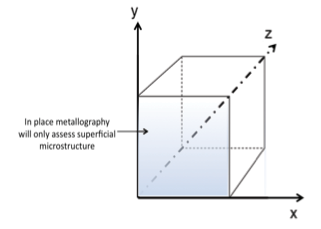Remote metallography, in-place metallography, in-situ metallography, and field replication are all examples of typical trade names of this great tool used for assessing the condition of a metal component. Often this method is used to determine if a metal component was exposed to high temperatures, allowing the observation of the microstructure of such component without the sample being removed.
The sample is prepared by conventional metallographic methods of grinding, polishing, and etching with a specific acid solution tailored to the alloy chemistry to reveal grain structure. An acetate tape is then applied to the surface, dampened with acetone, and a replica of the microstructure is created. The replica can then be analyzed with a portable microscope and the results can be interpreted on-site. Some might refer to this as a “non-destructive technique”, but technically, it IS a destructive technique. If the technique is performed by an experienced operator, you will obtain great results by removing about 5 mils from the surface of the test subject. Effective remote metallography heavily depends on the technique, and the results are only as good as the surface preparation. An improperly prepared surface will still yield results, but if artifacts are introduced during surface preparation, such artifacts might prevent a proper assessment of the sample’s microstructure.
One of the drawbacks of in-place metallography is that it only offers a two dimensional view of a 3-D object (i.e., only x and y directions, but not the z-direction) (Figure 1). An alternate testing method would be required to examine the bulk material if you are looking for sub-surface or bulk material defects such porosity or shrinkage. It is also important to choose a proper area to do such a test. If in-place metallography is performed at a loaded area, then the affected area might turn into a stress riser, possibly resulting in cracking.

Remote metallography is primarily aimed at assessing an area that has been exposed to high temperatures, such as tubes in a boiler, structural components exposed to fire, or even gas turbine blades. In-place metallography can also discern the differences between different cracking damage mechanisms, such as creep, fatigue, stress corrosion cracking, intergranular attack, as well as many others. In this case, it is important to have someone who can interpret and understand the microstructural features. Figure 2 shows a typical remote metallography kit that includes acetate tape, grinding discs of different grits, and a portable grinding wheel, among other things.
















Comments and Discussion
There are no comments yet.
Add a Comment
Please log in or register to participate in comments and discussions.